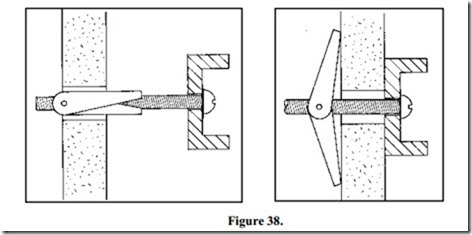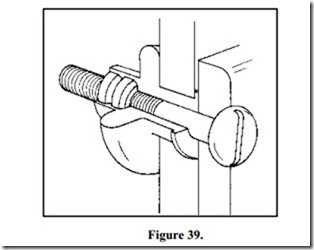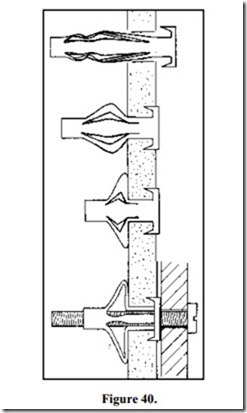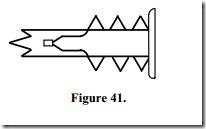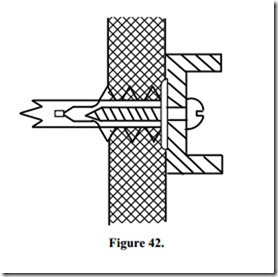Method of Fixing into Partition Walls
A fair proportion of electrical installation work involves fixing items to partition walls of various types. These may be plasterboard or timber walls for example. It is essential to know what fixing methods may be used.
Spring Toggle Fixings
The spring toggle consists of a plated steel, spring actuated toggle bar, pivoted on a swivel nut. When the nut has been run on to the end of the screw, the toggle is pushed through the fixing hole into the cavity whereupon it springs open and is then pulled back against the material to tighten the screw. The design of this fixing causes the load to be spread over a wide area.
The spring toggle is ideal for making fixings to cavity walls and ceilings where only one side of the material is accessible. It is especially effective when fixing to plasterboard and similar materials of low structural strength where, by embracing a comparatively wide area, reasonable loads can be supported.
N.B. If the screw of a spring toggle fixing is removed completely, the toggle will be lost inside the cavity.
Method of use:
· Drill a hole of suitable diameter through the partition into cavity
· Pass the fixing screw through the fixture and enter into nut.
· Pass the toggle through the hole in the partition and allow the toggle wings to spring apart.
· Pull on fixture while turning screw, to prevent toggle revolving inside cavity.
· Tighten screw until fixture is secure.
Rawlnut Multipurpose Fixing
The rawlnut fixing consists of a tough natural rubber sleeve with a non-ferrous nut bonded in one end, and a moulded external flange at the other. When the screw is tightened, the rubber sleeve compresses into a strong rivet fixing on the reverse side of the partition.
The rawlnut is suitable for securing fixtures to plasterboard, plastics, sheet metal, concrete and glass, to name but a few. It provides a fixing which is corrosion resistant, waterproof, vibration proof and electrically insulated.
N.B. When the screw is removed, the sleeve will remain in position and can be re-used.
Method of Use.
· Drill a hole of a suitable diameter in material.
· Insert rawlnut in hole up to external flange.
· Pass fixing screw through fixture and enter into rawlnut.
· Tighten screw to compress rubber sleeve until fixture is secure.
The interset is a plated steel cavity fixing, having one end internally threaded to receive a fixing screw. The other end has an external flange which is provided with teeth. These teeth penetrate the material and so prevent rotation. Fixing is achieved by deforming the legs into a large load bearing surface against the sheet material.The interset is suitable for securing fixtures to plasterboard and other similar materials. It provides a solid fixing and can achieve the maximum load that the material can support. See Figures 40.
N.B. If the screw is removed completely the interset will remain in position and can be reused.
Method of use.
· Drill a hole of a suitable diameter in material.
· Insert interset into hole and tap lightly to engage flange teeth in material.
· Pass fixing screw through fixture and enter into interset.
· Tighten screw to deform legs until fixture is secure.
N.B. A special interset fixing tool is available and would be an advantage in handling a large number of fixings.
Plasterboard Anchor
Figure 41 illustrates a zinc alloy plasterboard anchor which is quick and easy to install. One end is pointed to enable it to drill a pilot hole in the plasterboard. The other end consists of a flange which can be driven home using a pozidrive screwdriver. These are also available in plastic.
The plasterboard anchor features a deep thread form which ensures a strong engagement in the plasterboard. See Figure 42.
This fixing is manufactured specifically for use on plasterboard surfaces. Each fixing is supplied with its own fixing screw. The fixing remains in place in the plasterboard if the fixing screw is removed.
Method of use.
· Using a screwdriver, self drill anchor at the required position.
· Drive anchor until flange is flush with plasterboard.
· Pass fixing screw through fixture and enter into anchor.
· Tighten screw until fixture is secure.
